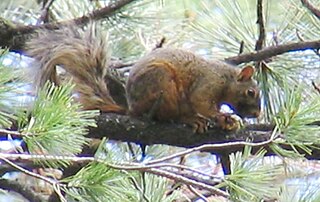 W
WBrachypelma hamorii is a species of tarantula found in Mexico. It has been confused with B. smithi; both have been called Mexican redknee tarantulas. Many earlier sources referring to B. smithi either do not distinguish between the two species or relate to B. hamorii. B. hamorii is a terrestrial tarantula native to the western faces of the Sierra Madre Occidental and Sierra Madre del Sur mountain ranges in the Mexican states of Colima, Jalisco, and Michoacán. The species is a large spider, adult females having a total body length over 50 mm (2 in) and males having legs up to 75 mm (3 in) long. Mexican redknee tarantulas are a popular choice for enthusiasts. Like most tarantulas, it has a long lifespan.
 W
WThe collared peccary is a species of artiodactyl (even-toed) mammal in the family Tayassuidae found in North, Central, and South America. It is the only member of the genus Dicotyles. They are commonly referred to as javelina, saíno, or báquiro, although these terms are also used to describe other species in the family. The species is also known as the musk hog. In Trinidad, it is colloquially known as quenk.
 W
WCrotalus pricei is a species of venomous snake, a pit viper in the family Viperidae. The species is endemic to the southwestern United States and northern Mexico. Two subspecies are recognized.
 W
WCrotalus willardi is a venomous pit viper species found in the southwestern United States and Mexico. This snake is found mainly in the "sky island" region. The IUCN reports this snake's conservation status as being of Least Concern. It is the official state reptile of Arizona.
 W
WThe Sierra Madre ground squirrel is a species of rodent in the squirrel family. It is endemic to the Sierra Madre Occidental, in northern Mexico. Its natural habitat is subtropical or tropical dry lowland grassland.
 W
WIctalurus pricei, the Yaqui catfish, is a species of North American freshwater catfish native to Mexico and Arizona.
 W
WThe Mexican wolf, also known as the lobo, is a subspecies of gray wolf native to southeastern Arizona and southern New Mexico in the United States, and northern Mexico; it also previously ranged into western Texas. It is the smallest of North America's gray wolves, and is similar to the extinct Great Plains wolf, though it is distinguished by its smaller, narrower skull and its darker pelt, which is yellowish-gray and heavily clouded with black over the back and tail. Its ancestors were likely the first gray wolves to enter North America after the extinction of the Beringian wolf, as indicated by its southern range and basal physical and genetic characteristics.
 W
WThe neotropical otter or neotropical river otter is an otter species found in Middle America, South America, and the island of Trinidad. It is physically similar to the northern and southern river otter, which occur directly north and south of this species' range. The length of the neotropical otter can range from 36–66 centimetres (14–26 in), plus a tail of 37–84 centimetres (15–33 in). Body weight ranges from 5–15 kilograms (11–33 lb). Otters are members of the family Mustelidae, the most species-rich family in the order Carnivora.
Panthea judyae is a moth of the family Noctuidae. It has been collected in the Mogollon Mountains and Big Burro Mountains of south-western New Mexico, the Huachuca Mountains of south-eastern Arizona, and the Sierra Madre Occidental of northern Mexico, at elevations of 1800–2400 m.
 W
WSceloporus jarrovii, also known commonly as the mountain spiny lizard and Yarrow's spiny lizard, is a species of lizard in the family Phrynosomatidae. The species is native to the southwestern United States and northern Mexico. There are two recognized subspecies.
 W
WSceloporus scalaris, the bunch grass lizard, is a species of small, phrynosomatid lizard.
 W
WThe Mexican fox squirrel (Sciurus nayaritensis) is a species of tree squirrel found throughout the Sierra Madre Occidental of Mexico as far south as Jalisco — and northward into the Chiricahua Mountains of southeastern Arizona, U.S.
 W
WThe Tarahumara salamander is a freshwater species of mole salamander in the family Ambystomatidae, endemic to Mexico. Its natural habitats are temperate forest, subtropical or tropical moist montane forest, subtropical or tropical high-altitude grassland, rivers, freshwater marshes, pastureland, and ponds.